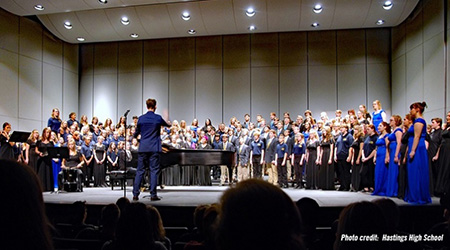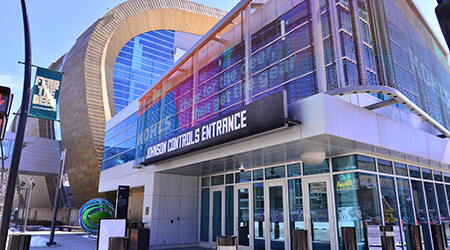
Case Study: Upgraded Acoustical Shell Improves Sound Quality at Performing Arts Center
January 21, 2022
The Hastings Performing Arts Center (HPAC), located in Hastings, Michigan, serves as a treasured destination for performing arts and creativity. The 830-seat facility hosts a wide range of student performances, music festivals and other events throughout the year. To optimize the functionality and acoustics of the space, the HPAC turned to the experts at Staging Concepts, who custom engineered a new acoustical shell and orchestra pit filler for the beloved auditorium.
Bravado Acoustical Shell
To enhance acoustics and the overall audience experience, the Staging Concepts team recommended a Bravado full-stage acoustical shell. Designed to blend and reflect sound energy toward audiences, the fully-customizable, state-of-the-art system consists of mobile towers and ceiling panels that align to form a resounding and attractive performance space.
Among the key advantages of the Bravado shell is its portability and ability to set up as a cohesive unit or in segmented pieces, allowing it to be customized based on the acoustic and spacing needs of individual events. Constructed of lightweight aluminum alloy, the portable, modular system includes an easy-to-use wheeled mover, making transporting and storing towers a simple and efficient process.
“It’s easy to change the layout with this system and you can set it up any way,” says Spencer White, band director for the HPAC.
To compliment the appearance of the existing layout at the HPAC, White and his team selected a soft white color for the shell panels. This provides a neutral backdrop that enables event producers and lighting designers to “paint” the space with accent lighting and visual effects that mirror the music’s tone and evoke emotion among the audience.
Orchestra Pit Filler
Moving downstage, a customized orchestra pit filler was installed at the HPAC to enable the fine tuning of larger ensembles, ensuring a musical balance between orchestral and choral groups. Panels may be added or removed on the fly to create an auditory experience customized to fit the needs of each individual performance.
“The pit filler meets and exceeds our needs for musicals and special productions,” says White. “When we have a large ensemble in the pit, we will only remove about half of the panels. This allows the musicians to play out and blend very well without covering up the voices on the stage. And when we have a smaller ensemble in the pit, we will remove more or all the panels. This ability to tune the pit’s balance with whatever is happening on stage for each event is a total game changer. It’s been incredible!”
Next
Read next on FacilitiesNet












